BY MIKE SALZANO
The basics are typically ignored when training at the firehouse. Firefighters love the fun activities like bailing out of windows and breaking things. Most company officers believe that their firefighters are, and expect them to be, capable enough to pull lines, conduct searches, and force entry. However, you can’t be good if you don’t train, and your goal should be to strive to be great, not just good.
So what’s the problem? The problem is that our brothers and sisters are dying inside “routine” residential fires. I get upset when I hear that a firefighter died in a 1,500-square-foot home. I believe that many of these line-of-duty deaths (LODDs) stem from complacency, lack of training, fewer fires, younger or inexperienced officers, and faster and hotter burning fuel. Whatever the reasons, none justify firefighters dying in a fire.
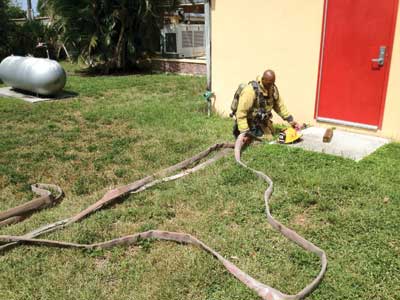 |
| (1) This is an example of a poorly laid out initial hoseline. It is laid to the wrong side of the door swing. The firefighter needs to get off his knees and don his self-contained breathing apparatus face mask, helmet, and gloves while constantly monitoring the conditions outside the building. (Photo by Robert Soto.) |
How do we fix these problems? First, we must get out and train. Pull lines, get hose on the ground, get on air more, do searches, practice vent-enter-search, and force doors. These drills are easy and not time consuming. You do not need a fire academy or a training facility to practice the basics; furthermore, you can easily build essential training props at your firehouse for under $150.
Most LODDs have something in common; it all starts with the domino effect. Typically, a small problem will start the domino effect. The majority of the time, the common denominator is a problem with the first line. Some examples might be the first line going limp inside a fire because of a kinked hoseline or an engine company’s running out of water. Many of these problems occur because of inefficiencies when laying and preparing the first line. If the first line is properly laid out, the fire will go out, and most problems will be avoided.
 |
| (2) This is a sloppy layout. You will struggle with this line the entire time it is being advanced into the building. (Photo by Robert Soto.) |
“FIRST LINE-FIRST 50” THEORY
The “first line-first 50” theory is simple. On your next duty day, have someone pull a line to the designated fire door and evaluate it. How does it look? Remember, you need to have a smooth transition into the house. Your size-up of the door is essential. Ask yourself where the door is in reference to the front of the structure (left side, right side, or in the middle). Does the door open to the left or to the right? Where is the fire or smoke in relation to the door? (This will dictate the side of the door you will lay your hose if there is the space to do so.) Laying the hose out on the opposite side of the door swing will ensure the hoseline does not get caught on the doorframe when the line is being advanced. It is crucial that the line flows and propels the crew inside the front door. The information you gather on your “approach” will help to ensure that your first line is deployed without a hitch. Approach slowly so you can “take in” everything the building is throwing at you (smoke conditions and color, fire location, entrance and egress locations, and hazards such as bars or hurricane windows). Figuring out the depth of the building you are about to enter is imperative. Knowing the depth will ensure you choose the right amount of hose to make it through the building to the deepest point and to the seat of the fire. If you are not proficient at gauging distances, use your fire engine. Many of today’s fire engines are approximately 35 feet long. If you can park one engine on the side of the building, you know the building is about 35 feet deep. If two engines can park side by side, then the building is approximately 70 feet deep.
 |
| (3) Note the large loops and how far away the nozzle, line, and “first 50 feet” are from the door. Not taking the time to set this line up properly will ensure crews work harder when advancing into the structure. (Photo by Stephen Shaw.) |
The first line must be set up perfectly. The “first line-first 50” theory involves flaking your initial 50 feet of attack line in neat accordion flakes no longer than eight to 10 feet wide within 15 feet of the front door or bringing the nozzle and the first coupling in a direct line to the front door. Normally, this first 50 feet will cover most of your dwellings or apartments. The second 50 feet can have larger loops in line behind the first 50 feet. This may sound pretty simple and basic. However, ask 10 firefighters to pull a line, and 10 out of 10 will deploy and set it up differently. Most lines will be laid out with huge flakes and no regard for neatness. None of this will matter if we do not have a team of firefighters working together to advance the line. When the line is laid out correctly, an engine company or team of firefighters can advance smoothly and not get hung up on the doorframe, furniture, and pivot points. Laying the line correctly will avoid having to pull a “clothesline stretch” full of water into the structure, increasing fatigue levels. Advancement is the next step to ensuring a smooth operation.
 |
| (4) This is an example of an effective layout in a tight area while still ensuring the “first 50 feet” are within 15 feet of the door and laid out on the correct side of the door swing. (Photo by author.) |
THREE FEET AT A TIME
I live by this “three-foot” rule. Don’t drag hose into the fire. As the nozzleman, pick up the hose, lock it under your forearms with the nozzle about three feet in front of you, and move it, three feet at a time, while staying low and operating the nozzle in a rotating or side-to-side motion. This technique uses your legs and lower body, not the hand-over-hand method taught in the fire academy.
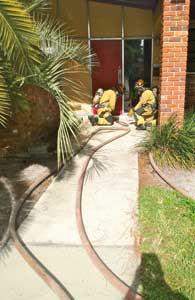 |
| (5) The nozzle and the first coupling were brought directly to the front door. The layout maintains a straight line back from the door and is great in tight, narrow spots. Placing the coupling and the nozzle at the front door always ensures 50 feet of line are ready for advancement. (Photo by Robert Soto.) |
Use the one leg up and forward technique, sliding the other knee forward as you advance (the front leg feels for the stability of the floor as you proceed forward on each step). Remember, at each interval, quickly sweep the floor to clear embers or debris while listening to what your hose stream is hitting. The sense of sound when directing the nozzle at the floor or toward a wall is great information as to where you are located and whether the floor is still intact. It is everyone’s job to ensure the initial hoseline is not jammed up. If this technique is done correctly, the officer and firefighter can move freely; the door man will work between three feet in the door and three feet out of the door; and the engineer can manage the outside line, making sure the flakes stay neat and stacked up in line with the front door.
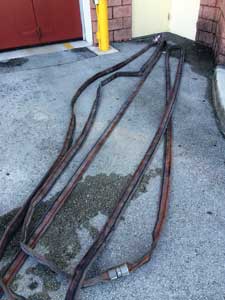 |
| (6) This stretch was done off of a “flat loaded” preconnected hoseline. When stretching the line from the rig, loops 1 and 3 and the nozzle were pulled from the engine. There are approximately 75 feet of line in a narrow area at the front door ready for advancement. Pay attention to the first section attached to the nozzle and how it is placed on top of the rest of the lines for smooth, frictionless deployment. (Photo by Garrett Pingol.) |
Once the officer and firefighter advance 15 to 25 feet in, the door man then graduates up the line to the next pivot point, and another firefighter takes his place at the door. If the stretch is long, each member graduates up the line, always maintaining communication and never going farther than 15 to 25 feet away from each other. The three-foot rule makes you stop for a few seconds every three feet, which ensures you are constantly monitoring conditions and communicating with your crew. Remember, if heat conditions are rapidly increasing as you advance, the room must be cooled, vented, or vacated. If not, you just might find yourself in a flashover.
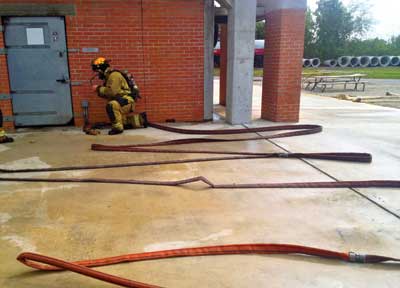 |
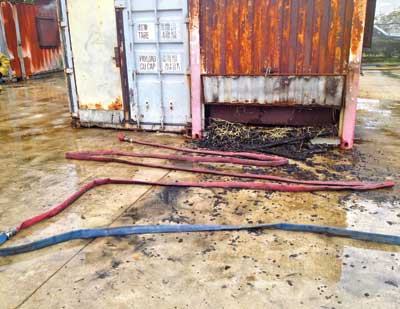 |
| (7-8) Note the tight accordion layout to the correct side of the door swing. By taking a few extra seconds to set these lines up perfectly, you avoid “fighting” the line all the way into the structure. Take note of how close the first coupling is to the front door. (Photos by author.) |
 |
| (9) This is a well-done layout. The first coupling is within 15 feet of the building, and all hose is to the right of the left-opening door. This layout takes patience and teamwork from the first-arriving engine and the driver-engineer. Note how the firefighter is not paying attention to his surroundings while donning his equipment and how far away from his side the “irons” were placed. (Photo by Robert Soto.) |
Ultimately, it is up to you, regardless of your rank and time on the job, to ensure that you are sharp, prepared, and ready for the next fire. Ask yourself, “Am I really good at what I do, or do I just think I am good because I have many years on the job?” Reevaluate the basics—first line deployment and readiness, forcible entry, and search techniques. Continue learning by taking a class or attending a conference. Get motivated. You and your company will be much more confident and ready when you step off the rig at your next working fire.
MIKE SALZANO is a lieutenant on Engine Co. 2 in the Fort Lauderdale (FL) Fire Department. He is the overall training coordinator for the Fort Lauderdale Fire Expo and a fire, live fire, and special operations instructor.
Fire Engineering Archives

